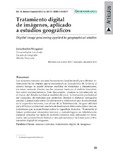Mostrar el registro sencillo del ítem
Tratamiento digital de imágenes, aplicado a estudios geográficos
| dc.rights.license | http://creativecommons.org/licenses/by-nc-sa/3.0/ve/ | |
| dc.contributor.author | Jordán Marquina, Jesús | |
| dc.date.accessioned | 2016-09-13T21:34:48Z | |
| dc.date.available | 2016-09-13T21:34:48Z | |
| dc.date.issued | 2013 | |
| dc.identifier.issn | 1316-6077 | |
| dc.identifier.uri | http://www.saber.ula.ve/handle/123456789/42267 | |
| dc.description.abstract | Los sensores remotos son una herramienta fundamental para obtener información de los objetos que se encuentran en la superficie de la tierra, al mismo tiempo se puede obtener medidas de distancias y dimensiones, sin tener contacto directo con los mismos, tanto en el ámbito físico-biótico como socioeconómico. Este documento plantea la introducción en el marco del diseño curricular establecido para la formación profesional del Geógrafo, de métodos que permitan, diseñar y elaborar cartografía precisa y actualizada sobre los elementos y fenómenos que se encuentran en la superficie terrestre, con el uso de la Teledetección, de gran utilidad para el futuro profesional analista de fenómenos físico-naturales y socioeconómicos que se manifiestan sobre la superficie terrestre. Transmitir al futuro profesional elementos teóricos y metodológicos en teledetección espacial, estudiar los tipos de sensores remotos más utilizados en Venezuela, sus características básicas y sus aplicaciones y las bases para el tratamiento digital de imágenes. | es_VE |
| dc.language.iso | es | es_VE |
| dc.publisher | SABER-ULA | es_VE |
| dc.rights | info:eu-repo/semantics/openAccess | |
| dc.subject | Sensores remotos | es_VE |
| dc.subject | Tratamiento digital de imágenes | es_VE |
| dc.title | Tratamiento digital de imágenes, aplicado a estudios geográficos | es_VE |
| dc.title.alternative | Digital image processing applied to geographical studies | es_VE |
| dc.type | info:eu-repo/semantics/article | |
| dc.description.abstract1 | Remote sensing is a key tool to get information about objects that are on the surface of the earth, at the same time it can obtain measurements of distances and dimensions, without direct contact with them, both in the physical-biotic and socio-economic field. This document proposes the introduction under the established curriculum for the training of Geographer, methods that allow to design and develop current and accurate mapping elements and phenomena found in the earth’s surface, with the use of Remote Sensing, which is useful for future professional analyst physical-natural and socioeconomic phenomena that occur on Earth’s surface. Therefore, this paper tries to teach to the future professional theoretical and methodological elements in spatial remote sensing in order to study the types of remote sensors used in Venezuela, its characteristics and the basis applications for digital image processing. | es_VE |
| dc.description.colacion | 69-79 | es_VE |
| dc.description.email | jordanmarquina@yahoo.es | es_VE |
| dc.description.frecuencia | semestral | |
| dc.identifier.depositolegal | 199-602TA950 | |
| dc.publisher.pais | Venezuela | es_VE |
| dc.subject.facultad | Núcleo Táchira (NUTULA) | es_VE |
| dc.subject.keywords | Remote sensing | es_VE |
| dc.subject.keywords | Digital image processing | es_VE |
| dc.subject.publicacionelectronica | Revista Geoenseñanza | |
| dc.subject.seccion | Revista Geoenseñanza: Artículos | es_VE |
| dc.subject.thematiccategory | Geografía | es_VE |
| dc.subject.tipo | Revistas | es_VE |
| dc.type.media | Texto | es_VE |
Ficheros en el ítem
Este ítem aparece en la(s) siguiente(s) colección(ones)
-
Geoenseñanza - Volumen 018(Número Especial) - 2013
Enero - Diciembre 2013


